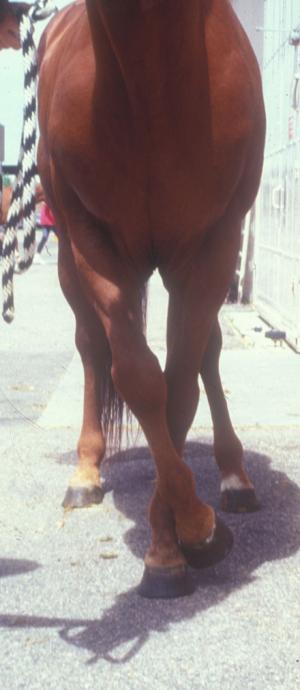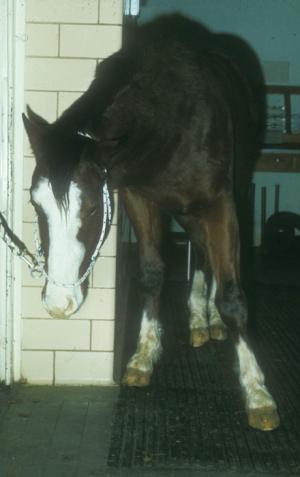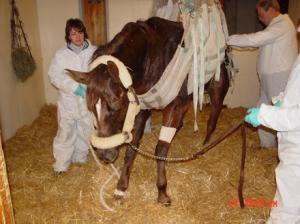EHV-1 White Paper
The Equine Research Coordination Group
Equine herpesvirus-1, also known as EHV-1, has been making headlines for the past few years. In 2011, some horses that had attended the National Cutting Horse Association Western National Championship in Ogden, Utah, began showing neurologic signs after leaving the event. This particular outbreak affected the equine industry in multiple states, and lead to fatalities in some horses that developed the neurologic form of EHV-1, called equine herpesvirus myeloencephalopathy (EHM).
EHV-1 is highly contagious to other horses and can cause respiratory disease primarily in juvenile horses, such as nasal discharge, fever and coughing; infection can also result in abortion and neonatal death. The most concerning manifestations of EHV-1 infection are neurological signs, such as a wobbly gait caused by lack of coordination of the limbs, with the hind limbs often more severely affected, as well as urinary incontinence. These appear when the virus causes damage to blood vessels in the brain and spinal cord. Though EHM is not new, more outbreaks are being recognized, with more horses seeming to be affected in each outbreak, causing concern among many equine owners.
EHV-1 can affect horses of all breeds and ages, and is spread via direct contact (nose-to-nose contact), indirect contact (from shared water buckets or tack, as well as from people’s hands), and through the air (aerosolized transmission).
Though there are many vaccines containing EHV-1 (the rhinopneumonitis vaccine your horse typically gets in his regular vaccine series), there is no vaccine currently on the market that has a label claim for prevention of the neurologic form of the disease. The goal of vaccination is to boost immunity in order to control respiratory disease or abortion resulting from of EHV-1 infection.
Most horses have been exposed to and infected by EHV-1 by the time they are 2-year-olds (typically as they are foals in contact with their dams). Often the virus becomes inactive once the horse is infected, but the animal will remain a life-long carrier of the virus. These carriers may show no outward signs of infection with EHV-1, though the virus can be re-activated should the horse become stressed, such as during transport, weaning or intense exercise. Once activated, the virus can spread via the aerosol route (even from a seemingly “healthy” horse).
How To Prevent It
Implementing basic biosecurity measures are key to preventing the spread of EHV-1, according to Dr. Nicola Pusterla, DVM, PhD, Diplomate ACVIM and professor at University of California-Davis School of Veterinary Medicine. He concedes that while no horse owner will be able to eliminate all risks, everyday precautions should be taken, including washing hands, using a separate pair of boots when visiting other farms, and keeping horses that leave the premises separate from those that live on the farm full-time. Simply knowing the health status of other horses your horse might come into contact with can minimize the risk of spreading the disease to your horse.
If your horse travels, Dr. Josie Traub-Dargatz, DVM, MS, Diplomate ACVIM and professor at Colorado State University College of Veterinary Medicine and Biomedical Sciences, suggests taking daily temperatures while he is away from his home base and then continuing to monitor his temperature for about a week once he returns. Though the incubation period for EHV-1 can be as short as 24 hours, horses begin to show signs typically a few days after exposure. Dr. Traub-Dargatz notes that the horse may only have mild fever, slight nasal discharge or a cough (some horses exhibit no signs of disease) before neurologic signs develop, so careful monitoring is key.
If you find your horse’s temperature to be above the normal 99 to 101.5 degrees Fahrenheit, you should contact your veterinarian, who will do a physical examination and, if indicated, will take both a nasal swab and a blood sample, and send them to a laboratory to be tested.
Should these tests come back positive for EHV-1 and your horse is showing neurologic signs, there is no “quick fix;” your veterinarian will base treatment on clinical and laboratory information available. Treatment with anti-inflammatories is often given. Antiviral drugs have also been used to treat EHV-1 cases.
Contracting the neurologic form of EHV-1 is not a death sentence; some horses may recover fully while others have life-long neurologic deficits to which some can adapt. According to Dr. Pusterla, 5 to 30 percent of horses that contract EHV-1 will develop EHM; of these EHM cases, 5 to 50 percent will necessitate euthanasia. Dr. Pusterla stressed that each neurologic case should be evaluated on a case-by-case basis.
Research Continues
Veterinarians in the cutting horse industry who were faced with the EHV-1 outbreak stated that recent research into the disease was very helpful in shaping their treatment plans for affected horses. EHV-1 has been among the priorities of research universities and funding agencies for some time, but there is still much to be learned, including how to effectively contain the disease and how to treat horses that have contracted the disease.
Dr. Traub-Dargatz notes that multiple issues need to be investigated, including discovering what, beyond infection with EHV-1, contributes to the disease; the role of stress in the predisposition to EHV-1; how far the disease can spread; and how long it can survive in the environment. Thus far, the impact of treatment under field conditions has not been widely studied in a regimented way that allows veterinarians to determine the efficacy of the various treatments. Since there has not been a reliable way to recreate the disease other than in the geriatric horse challenge model, doing challenge studies to determine efficacy of treatment has limitations. Both Drs. Traub-Dargatz and Pusterla agree that collection of information from horses with EHM – occurring during EHV-1 outbreaks, as well as from non-affected horses (controls), is necessary to learn more about potential risk factors for the disease.
More photos available at: http://www.aaep.org/ehv_paperphotos.htm
Photos:
Image 1: Photograph of horse with front legs crossed that illustrates lack of proprioception (knowing where his front legs are placed). (Photo by James Ingram, DVM)
Image 2: Photograph of horse with a wide based stance in forelimbs and hanging its head. Illustrates lack of proprioception (does not perceive that front legs are out of normal posture when standing) and dull mentation. (Photo by James Ingram, DVM)
Image 3: Photograph showing horse with hind limbs out of normal position, e.g. forward and close together, illustrates hind limb weakness as well as wobbly gait. (Photo by James Ingram, DVM)
Image 4: Photograph of a filly finally standing, but struggling, even with some help. (Photo Courtesy of Stephen M. Reed, DVM, Dipl. ACVIM)
The Equine Research Coordination Group
Equine herpesvirus-1, also known as EHV-1, has been making headlines for the past few years. In 2011, some horses that had attended the National Cutting Horse Association Western National Championship in Ogden, Utah, began showing neurologic signs after leaving the event. This particular outbreak affected the equine industry in multiple states, and lead to fatalities in some horses that developed the neurologic form of EHV-1, called equine herpesvirus myeloencephalopathy (EHM).
EHV-1 is highly contagious to other horses and can cause respiratory disease primarily in juvenile horses, such as nasal discharge, fever and coughing; infection can also result in abortion and neonatal death. The most concerning manifestations of EHV-1 infection are neurological signs, such as a wobbly gait caused by lack of coordination of the limbs, with the hind limbs often more severely affected, as well as urinary incontinence. These appear when the virus causes damage to blood vessels in the brain and spinal cord. Though EHM is not new, more outbreaks are being recognized, with more horses seeming to be affected in each outbreak, causing concern among many equine owners.
EHV-1 can affect horses of all breeds and ages, and is spread via direct contact (nose-to-nose contact), indirect contact (from shared water buckets or tack, as well as from people’s hands), and through the air (aerosolized transmission).
Though there are many vaccines containing EHV-1 (the rhinopneumonitis vaccine your horse typically gets in his regular vaccine series), there is no vaccine currently on the market that has a label claim for prevention of the neurologic form of the disease. The goal of vaccination is to boost immunity in order to control respiratory disease or abortion resulting from of EHV-1 infection.
Most horses have been exposed to and infected by EHV-1 by the time they are 2-year-olds (typically as they are foals in contact with their dams). Often the virus becomes inactive once the horse is infected, but the animal will remain a life-long carrier of the virus. These carriers may show no outward signs of infection with EHV-1, though the virus can be re-activated should the horse become stressed, such as during transport, weaning or intense exercise. Once activated, the virus can spread via the aerosol route (even from a seemingly “healthy” horse).
How To Prevent It
Implementing basic biosecurity measures are key to preventing the spread of EHV-1, according to Dr. Nicola Pusterla, DVM, PhD, Diplomate ACVIM and professor at University of California-Davis School of Veterinary Medicine. He concedes that while no horse owner will be able to eliminate all risks, everyday precautions should be taken, including washing hands, using a separate pair of boots when visiting other farms, and keeping horses that leave the premises separate from those that live on the farm full-time. Simply knowing the health status of other horses your horse might come into contact with can minimize the risk of spreading the disease to your horse.
If your horse travels, Dr. Josie Traub-Dargatz, DVM, MS, Diplomate ACVIM and professor at Colorado State University College of Veterinary Medicine and Biomedical Sciences, suggests taking daily temperatures while he is away from his home base and then continuing to monitor his temperature for about a week once he returns. Though the incubation period for EHV-1 can be as short as 24 hours, horses begin to show signs typically a few days after exposure. Dr. Traub-Dargatz notes that the horse may only have mild fever, slight nasal discharge or a cough (some horses exhibit no signs of disease) before neurologic signs develop, so careful monitoring is key.
If you find your horse’s temperature to be above the normal 99 to 101.5 degrees Fahrenheit, you should contact your veterinarian, who will do a physical examination and, if indicated, will take both a nasal swab and a blood sample, and send them to a laboratory to be tested.
Should these tests come back positive for EHV-1 and your horse is showing neurologic signs, there is no “quick fix;” your veterinarian will base treatment on clinical and laboratory information available. Treatment with anti-inflammatories is often given. Antiviral drugs have also been used to treat EHV-1 cases.
Contracting the neurologic form of EHV-1 is not a death sentence; some horses may recover fully while others have life-long neurologic deficits to which some can adapt. According to Dr. Pusterla, 5 to 30 percent of horses that contract EHV-1 will develop EHM; of these EHM cases, 5 to 50 percent will necessitate euthanasia. Dr. Pusterla stressed that each neurologic case should be evaluated on a case-by-case basis.
Research Continues
Veterinarians in the cutting horse industry who were faced with the EHV-1 outbreak stated that recent research into the disease was very helpful in shaping their treatment plans for affected horses. EHV-1 has been among the priorities of research universities and funding agencies for some time, but there is still much to be learned, including how to effectively contain the disease and how to treat horses that have contracted the disease.
Dr. Traub-Dargatz notes that multiple issues need to be investigated, including discovering what, beyond infection with EHV-1, contributes to the disease; the role of stress in the predisposition to EHV-1; how far the disease can spread; and how long it can survive in the environment. Thus far, the impact of treatment under field conditions has not been widely studied in a regimented way that allows veterinarians to determine the efficacy of the various treatments. Since there has not been a reliable way to recreate the disease other than in the geriatric horse challenge model, doing challenge studies to determine efficacy of treatment has limitations. Both Drs. Traub-Dargatz and Pusterla agree that collection of information from horses with EHM – occurring during EHV-1 outbreaks, as well as from non-affected horses (controls), is necessary to learn more about potential risk factors for the disease.
More photos available at: http://www.aaep.org/ehv_paperphotos.htm
Photos:
Image 1: Photograph of horse with front legs crossed that illustrates lack of proprioception (knowing where his front legs are placed). (Photo by James Ingram, DVM)
Image 2: Photograph of horse with a wide based stance in forelimbs and hanging its head. Illustrates lack of proprioception (does not perceive that front legs are out of normal posture when standing) and dull mentation. (Photo by James Ingram, DVM)
Image 3: Photograph showing horse with hind limbs out of normal position, e.g. forward and close together, illustrates hind limb weakness as well as wobbly gait. (Photo by James Ingram, DVM)
Image 4: Photograph of a filly finally standing, but struggling, even with some help. (Photo Courtesy of Stephen M. Reed, DVM, Dipl. ACVIM)










